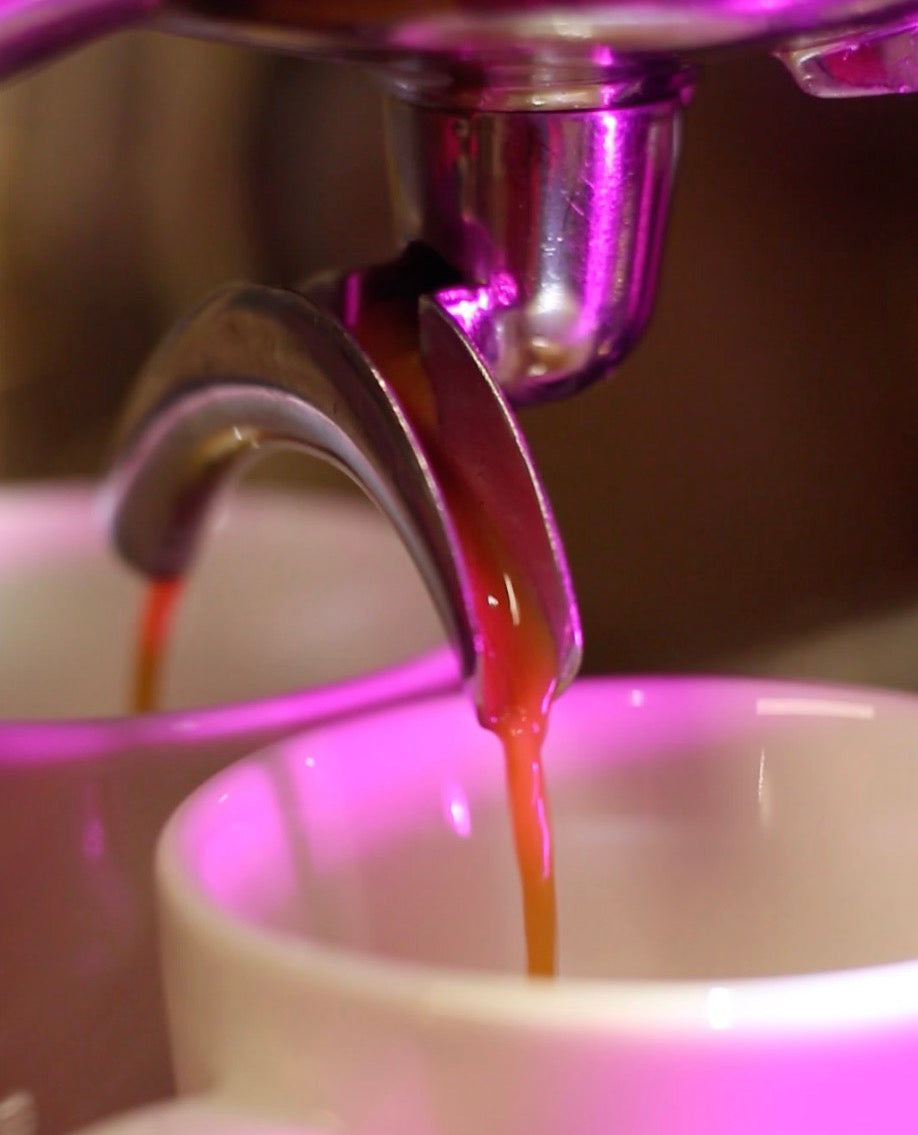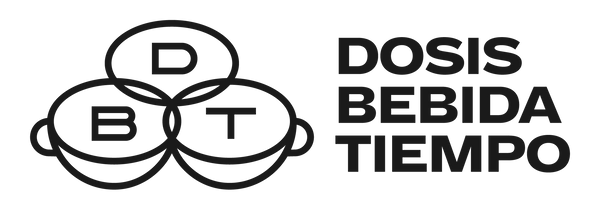Coffee Information
From my role as roaster at 3 Ciclos , I remember when we first discovered Finca La Reserva's Caturra Chiroso honey, a couple of years ago. We loved its sweetness and body. We also loved that it was a very fruity coffee, but not citrusy, which not only made it unusual, but also allowed it to be an extremely popular coffee. Notes of Turkish apricots seduced us.
We launched this coffee in collaboration with Café Botánico , on the occasion of their anniversary and a small series of workshops that we held at their premises in La Serena. Then, the next harvest arrived, but it was different. An extremely floral and delicate coffee, but with a very high sweetness, and a very creamy texture. We were surprised by the change. Here, the notes ranged from hibiscus and elderberry to pastry cream.
The change was mainly in the post-harvest process, going from a honey that had been dried for 72 hours to a honey that had been fermented in an anaerobic environment for 96 hours. This process allowed the variety to come out more in line with its traceability as an Ethiopian landrace.
Back in December 2023, we learned of an exceptional batch from the same farm, the Wush Wush variety —whose origin also dates back quite directly to Ethiopia— , and with an anaerobic fermentation process and extended drying. This coffee is everything one could ask for in a well-executed natural: floral, with a juicy texture, high complexity, and lots of fruit.
Producer: La Reserva Estate
Country: Colombia.
Region: Antioquia, Bolivar City
Altitude: 2100 mts.
Variety: Wush Wush.
Post-harvest process: Fermentation in an anaerobic environment for 160 hours, cherry drying for 20 days.
Harvest: October 2023.
Sensory Description
Pigeon heart cherry, ripe mango, prickly pear melon, apricot nectar, watermelon, concord grape, yuzu.
Bright and juicy acidity, high round sweetness and medium-low herbal bitterness.
Medium body, creamy texture and persistent finish.
Import
This coffee was purchased directly from Manantial Coffee Chile , who imported it to Chile. The cost per kilo was CLP $35,581. This does not include operating costs, design or packaging —developed in conjunction with Sangre Artificial— .
Roasting
Roasting this coffee was extremely complex, as it is quite heavy in processing, but without any sharp fermented flavors, making it considerably fragile. I noticed that with roasts comparable to other coffees we have released, the acidity and clarity of some flavors were very muted.
So I opted for one of the lightest roasts I have ever done, both in terms of final temperature and total roasting time. I was surprised that, despite being a roast that I would consider extremely light, the coffee flavors come through very intensely.
Now, because it is such a light roast, I highly recommend resting it for at least 2 weeks for best results.
Toaster: Kaffelogic Nano 7
Load: 90 grams
Initial humidity: 11%, rehydrated to 16%
Total Time: 5 minutes, 20 seconds.
DTR: 19.9%
Final Temperature: 213.6 ºC
Accumulated Temperature*: 7.4
Mass loss: 16.2%

*We calculate this value by dividing the area under the roasting curve by the load, ([ºC x min] / grams). We consider this value, in our roaster, to be a reasonable approximation of the development of the coffee, in a broad sense.
Water
All King Solomon coffees are cupped with water that follows the recipe below, which we recommend for the best possible results. If you prefer a simpler option, we recommend using Nomadic Waters , since that is the water we commonly use.
To get to the recipe below you need to first make a couple of mineral concentrates. We used the recipes from Barista Hustle . Our water recipe aims for the highest extraction possible, and a balance between acidity, sweetness and bitterness.
Recipe:
— 185 ppm** of Magnesium Sulfate ( MgSO₄ ); that is, 185 grams of the Hardness concentrate.
— 38 ppm** of Sodium Bicarbonate ( NaHCO₃ ), that is, 38 grams of Buffer concentrate.
— 777 grams of deionized, demineralized or distilled water.
**As an equivalent in CaCO3.
To make things simpler, we will soon be launching our own bottled water, ready to use. Stay tuned!
Preparation
In general, our coffees are designed for high extractions. We recommend fine grinds, higher temperatures, and longer ratios—for filtered, between 1:20 and 1:23; for espresso, between 1:3 and 1:5. In addition, we tend to prefer relatively low concentrations, where we find the greatest clarity in descriptors.
The idea of including recommended recipes is not to prevent you from experimenting with coffee, but to share the recipes with which we have had good results.
Manual percolation coffee makers ( conical or flat bottom, such as V60, Origami, Kalita Wave, Kono, etc.)
Dose: 10 grams.
Water: 170 grams.
Drink: 150-160 grams.
Time : 3 - 4 minutes.
Temperature: 92-94ºC in Santiago.
TDS: 1.2 - 1.3%.
First discharge — saturation or bloom — 35 grams, swirl the coffee maker for 5 seconds making sure all the coffee is wet.
Second pour of 45 grams (80) at 30 seconds. Move the coffee maker gently in circles for 2 seconds.
Third pour of 45 grams (125) just after the water level reaches the coffee. Move the coffee maker gently in circles for 2 seconds.
Final pour of 45 grams (170) just after the water level reaches the coffee. Move the coffee maker gently in circles for 2 seconds.
For increased complexity, conical makers are recommended, while for balance and clarity, flat-bottomed makers are preferable.
It is recommended to reach something close to these parameters with another coffee first. Try to make all pours from the highest possible height that does not break the flow or generate bumps on the surface of the water, in a circular motion over the coffee and maintaining a controlled flow. In addition, it is recommended to keep the water boiling between pours.
Immersion coffee makers (such as AeroPress, French Press, Hario Switch, Clever, etc.)
Dose: 10 grams.
Water: 160 grams.
Drink: 145-155 grams.
Time: 8 - 9 minutes.
Temperature: Boiling; 97ºC in Santiago
TDS: 1.3 - 1.4%
[AeroPress, standard method]
Pour the 160 grams of water over the coffee, trying to pour as quickly and from as high as possible so as not to create any bumps on the surface of the water. Stir carefully, making sure to wet all the coffee evenly.
Insert the plunger without applying pressure to create a vacuum.
At 7 1/2 minutes, with the plunger still inserted, gently move the pot in a circular motion for 5 seconds.
At 8 minutes, begin pressing the plunger very gently for 30 to 60 seconds; press all the way down.
For other immersion coffee makers, use the same proportions and start filtering after 8 minutes. For a French press, leave the filter at the level of the drink's surface, do not press all the way to the bottom and pour gently.
It is recommended to first reach something close to these parameters with another coffee, and use the finest grind with which it is still easy to press the plunger smoothly.
Espresso
Dose: 15 grams.
Water: The water you use in your espresso machine, or the recipe indicated, if you have a machine that allows it easily.
Drink: 45-50 grams.
Time: 20-25 seconds.
Pressure from pump: 6 bar
Temperature: 91-93ºC
TDS: 7 - 8%
It is recommended to reach something close to these parameters beforehand with another coffee. Let the drink cool a little before tasting. For something like a allongé , use the same parameters, but aim for a 75-90 gram drink in about 30-40 seconds. For something like a sprover , aim for 190-200 grams in about 45-60 seconds.
Zero bypass coffee makers (Tricolate, LVL-10 and Pulsar)
Dose: 20 grams.
Water: 360 grams, recipe included.
Drink: 335 - 345 grams.
Time: 4-5 minutes.
Temperature: Boiling; 97ºC in Santiago
TDS: 1.3 - 1.5%
[Press]
First pour —saturation or bloom— of 60 grams with the valve closed, move the coffee maker for 10 seconds ensuring that all the coffee is wet or stir carefully with WDT tool.
Pour 60 grams (120) at 30 seconds.
Open the valve to half flow (45°) after 60 seconds.
Pour the remaining 240 grams (360) in 5-7 pulses, each time until the water is 0.5-1 cm above the coffee level. Move the coffee maker gently in circles for 3 seconds after each pulse.
For the Next Level LVL-10, use 30 grams of coffee to 540 grams of water, with a slightly coarser grind; for the Tricolate, use between 15-25 grams of dose and maintain the ratio. For both machines, maintain bloom times.
For other zero-bypass coffee makers, keep the proportions but use the dosage recommended by the manufacturer. Try to do everything on a surface that allows you to keep the coffee maker level at all times. It is recommended to reach something close to these parameters beforehand with another coffee. In addition, it is recommended to keep the water boiling between pours.
Finally, to increase juiciness, it is recommended to increase the ratio to 1:15 - 1:16. To optimize the balance, it is recommended to decrease the ratio to 1:20 - 1:21.
Music
All of our coffees also come with a Spotify playlist, featuring songs we like to listen to while brewing and drinking. Generally, the songs we include in each playlist relate to some sensory aspect of coffee; but explaining exactly how they relate goes beyond words.
Listen to Wush Wush Finca La Reserva on Spotify.


